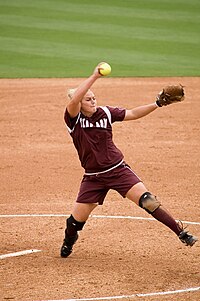
Photo from wikipedia
Feint movement is an important factor for offensive players to outplay their guard, and score. So far, there is no evidence of feint biomechanical analysis on a sample of elite… Click to show full abstract
Feint movement is an important factor for offensive players to outplay their guard, and score. So far, there is no evidence of feint biomechanical analysis on a sample of elite players in handball or other team sports. Therefore, this study aimed to investigate kinematic parameters of single side fake movement between elite and professional level handball players. The sample of participants consisted of 10 handball players divided into two subsamples: elite handball players (100.00 ± 8.00 kg; 196.00 ± 4.64 cm) and professional handball players (91.20 ± 3.42 kg; 192.4 ± 7.30 cm). The kinematic analysis was conducted using a GAIT—LaBACS software system. Variables consisted of two phases (fake phase and actual phase) of feint single change of direction. Both phases included seven kinematic parameters that were observed. Statistical analysis included descriptive statistic parameters. The differences between elite and professional handball players were analyzed by multivariate and univariate variance analysis. Results showed significant differences between elite and professional players (λ = 0.44, p = 0.00), in fake phase (i.e., 1. Phase). The results also indicate that in there is no statistically significant difference between both groups (λ = 0.64, p = 0.22). Two variables had significant differences between elite and professional players (i.e., step length of the stride leg (p = 0.02) and moving the leg opposite the throwing arm in space (p = 0.00)). To conclude, the article examines specific movement patterns of single side fake movement in elite players and the confirmed importance of efficient skill execution in top level handball. On the contrary, less skilled players use more space for the same technical element.
Journal Title: Journal of Functional Morphology and Kinesiology
Year Published: 2023
Link to full text (if available)
Share on Social Media: Sign Up to like & get
recommendations!